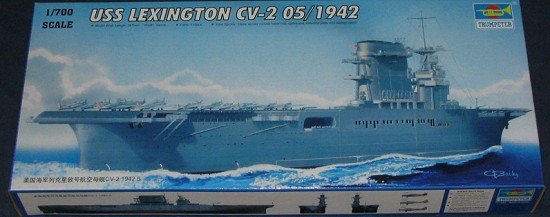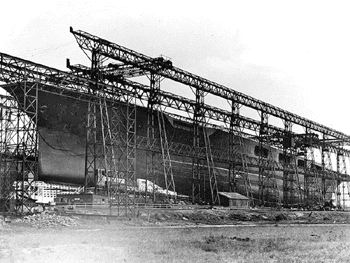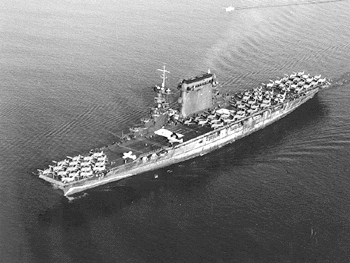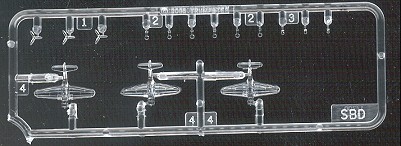|
KIT: |
Trumpeter 1/700
USS Lexington, CV-2 - May 1942 |
|
KIT #: |
05716 |
|
PRICE: |
$27.95 |
|
DECALS: |
One ship with
airwing. |
|
REVIEWER: |
Scott Van Aken |
|
NOTES: |
Can be built as
waterline or full hull |

displacement: 41,000 tons
length: 888 feet
beam: 105½ feet
draft: 32 feet
speed: 34¼ knots
complement: 2,122 crew
armament: 8 eight-inch and 12 five-inch guns (as originally fitted)
aircraft: 81
class: Lexington
From: Dictionary of American
Fighting Ships, published by the
Naval Historical Center
Full-screen images are linked from the images in the text below.

The fourth Lexington (CV 2)
was originally designated CC 1; laid down as a battle cruiser 8 January
1921 by Fore River Shipbuilding Co., Quincy, Mass.; authorized to be
completed as an aircraft carrier 1 July 1922; launched 3 October 1925;
sponsored by Mrs. Theodore Douglas Robinson, wife of the Assistant
Secretary of the Navy; and commissioned 14 December 1927, Capt. Albert W.
Marshall in command.
After fitting out and shakedown,
Lexington joined the battle fleet at San Pedro, Calif., 7 April 1928.
Based there, she operated on the west coast with Aircraft Squadrons, Battle
Fleet, in flight training, tactical exercises, and battle problems . Each
year she participated in fleet maneuvers in the Hawaiians, in the
Caribbean, off the Panama Canal Zone, and in the eastern Pacific.
On 16 January 1930, Lexington
completed a 30-day period in which she furnished electricity to the city of
Tacoma, Wash., in an emergency arising from a failure of the city's power
supply. The electricity from the carrier totaled more than 4.25 million
kilowatt-hours.
In the fall of 1941 she sailed with
the battle force to the Hawaiians for tactical exercises.
On 7 December 1941 Lexington
was at sea with Task Force 12 (TF 12) carrying marine aircraft from Pearl
Harbor to reinforce Midway when word of the Japanese attack on Pearl Harbor
was received. She immediately launched searchplanes to hunt for the
Japanese fleet , and at mid-morning headed south to rendezvous with USS
Indianapolis (CA 35) and
USS Enterprise (CV 6) task forces to conduct a search southwest
of Oahu until returning Pearl Harbor 18 December.
 Lexington sailed next day to
raid Japanese forces on Jaluit to relieve pressure on Wake; these orders
were canceled 20 December, and she was directed to cover the
USS Saratoga force in reinforcing Wake. When the island fell 23
December, the two carrier forces were recalled to Pearl Harbor, arriving 27
December.
Lexington sailed next day to
raid Japanese forces on Jaluit to relieve pressure on Wake; these orders
were canceled 20 December, and she was directed to cover the
USS Saratoga force in reinforcing Wake. When the island fell 23
December, the two carrier forces were recalled to Pearl Harbor, arriving 27
December.
Lexington patrolled to block
enemy raids In the Oahu-Johnston-Palmyra triangle until 11 January 1942,
when she sailed from Pearl Harbor as flagship for Vice Adm. Wilson Brown
commanding TF 11. On 16 February, the force headed for an attack on Rabaul,
New Britain, scheduled for 21 February. While approaching the day previous,
Lexington was attacked by two waves of enemy aircraft, nine planes
to a wave. The carrier's own combat air patrol and antiaircraft fire
splashed 17 of the attackers. During a single sortie Lt. E. H (Butch)
O'Hare won the Medal of Honor by downing five planes.
Her offensive patrols in the Coral
Sea continued until 6 March, when she rendezvoused with USS Yorktown's
TF 17 for a thoroughly successful surprise attack flown over the Owen
Stanley mountains of New Guinea to inflict heavy damage on shipping and
installations at Salamaua and Lae 10 March. She now returned to Pearl
Harbor, arriving 26 March 1942. Lexington's task force sortied from
Pearl Harbor 15 April, rejoining TF 17 on 1 May. As Japanese fleet
concentrations threatening the Coral Sea were observed, Lexington
and
USS Yorktown (CV 5) moved into the sea to search for the enemy's
force covering a projected troop movement. The Japanese must now be blocked
in their southward expansion, or sea communication with Australia and New
Zealand would be cut, and the dominions threatened with invasion.
On 7 May 1942 search planes reported
contact with an enemy carrier task force, and Lexington's air group
flew an eminently successful mission against it, sinking light carrier
Shoho. Later that day, 12 bombers and 15 torpedo planes from still-unlocated
heavy carriers Shokaku and Zuikaku were intercepted by
fighter groups from Lexington and Yorktown, who splashed nine
enemy aircraft.
On the morning of the 8th, a
Lexington plane located the Shokaku group. A strike was
immediately launched from the American carriers, and the Japanese ship was
heavily damaged.
 The enemy penetrated to the American
carriers at 1100, and 20 minutes later Lexington was struck by a
torpedo to port. Seconds later, a second torpedo hit to port directly
abreast the bridge. At the same time, she took three bomb hits from enemy
dive bombers, producing a seven degree list to port and several raging
fires. By 1300 her skilled damage control parties had brought the fires
under control and returned the ship to even keel. Making 25 knots, she was
ready to recover her air group. Then suddenly Lexington was shaken
by a tremendous explosion, caused by the ignition of gasoline vapors below,
and again fire raged out of control.
The enemy penetrated to the American
carriers at 1100, and 20 minutes later Lexington was struck by a
torpedo to port. Seconds later, a second torpedo hit to port directly
abreast the bridge. At the same time, she took three bomb hits from enemy
dive bombers, producing a seven degree list to port and several raging
fires. By 1300 her skilled damage control parties had brought the fires
under control and returned the ship to even keel. Making 25 knots, she was
ready to recover her air group. Then suddenly Lexington was shaken
by a tremendous explosion, caused by the ignition of gasoline vapors below,
and again fire raged out of control.
At 1558 Capt. Frederick C. Sherman,
fearing for the safety of men working below, secured salvage operations,
and ordered all hands to the flight deck. At 1707, he ordered, "abandon
ship!", and the orderly disembarkation began, men going over the side into
the warm water, almost immediately to be picked up by nearby cruisers and
destroyers. Admiral Fitch and his staff transferred to cruiser USS
Minneapolis (CA 36); Captain Sherman and his executive officer, Cmdr.
M. T. Seligman insured all their men were safe, then were the last to leave
their ship.
Lexington blazed on, flames
shooting hundreds of feet into the air. The destroyer USS Phelps (DD
360) closed to 1500 yards and fired two torpedoes into her hull. With one
last heavy explosion, Lexington sank at 1956 on 8 May 1942 at 15º
20' S., 155º 30' E. She was part of the price that was paid to halt the
Japanese overseas empire and safeguard Australia and New Zealand, but
perhaps an equally great contribution had been her pioneer role in
developing the naval aviators and the techniques which played so vital a
role in ultimate victory in the Pacific.
Lexington received two battle
stars for World War II service.
Historical background courtesy of the
Naval Historical Center.
 It
seems as if Trumpeter is going to panatagraph down all of its big scale
kits (and perhaps this will work the other way as well). This is great news
as the very old Fujimi Lexington has been commanding very high prices on
the auction sites. This will effectively stop that as this kit is light
years ahead of the older Japanese version in every way. For one thing,
there are over 500 parts in this one. Sure, many of those are from the air
wing, where each aircraft is five parts, but still, there are tons of small
guns and other fittings.
It
seems as if Trumpeter is going to panatagraph down all of its big scale
kits (and perhaps this will work the other way as well). This is great news
as the very old Fujimi Lexington has been commanding very high prices on
the auction sites. This will effectively stop that as this kit is light
years ahead of the older Japanese version in every way. For one thing,
there are over 500 parts in this one. Sure, many of those are from the air
wing, where each aircraft is five parts, but still, there are tons of small
guns and other fittings.
As with the Kuznetsov, this one has a
nice acrylic base with wave action and everything. A great way to display a
waterline model. Of course, you can build it full hull if you wish and a
nice piece of 'dry dock'
stand is provided for that purpose.
The level of detail is all that one
could expect from a modern Trumpeter ship kit. You'll spend the first of
the construction steps working on situating the myriad of sponsons and
anti-aircraft guns that come with this kit. The two ship's elevators are
molded in such a way that you can pose them in any position that you wish.
However, the small extension on the forward elevator is molded to the deck
in the up position.
There is no hangar deck with this
kit, however, it does include a one-piece flight deck. That should make it
much easier to install. The island structure follows Trumpeter's norm in
that there is a core to which you attach bulkheads. Both this structure and
the stack structure are festooned with anti-aircraft guns as well.
 Also included are a number of
aircraft. Each one of these is a mini-model. They consist of the basic
airframe to which you attach the three landing gear and a prop. Yep, in
1/700 scale these are tiny. The aircraft are molded in clear plastic so
that you'll have a clear canopy. However, you'll be looking at whatever the
underside color is so perhaps the builder will want to paint the bottom
black before proceeding the the usual colors. These will be the Blue-Grey
uppers with Light Grey undersides. A full set of markings are provided as
well.
Also included are a number of
aircraft. Each one of these is a mini-model. They consist of the basic
airframe to which you attach the three landing gear and a prop. Yep, in
1/700 scale these are tiny. The aircraft are molded in clear plastic so
that you'll have a clear canopy. However, you'll be looking at whatever the
underside color is so perhaps the builder will want to paint the bottom
black before proceeding the the usual colors. These will be the Blue-Grey
uppers with Light Grey undersides. A full set of markings are provided as
well.
 You
get 12 SBD-3 Dauntlesses, 12 F4F-3 Wildcats and 6 TBD-1 Devestators. One of
my Dauntless bombers was molded without a tail section so I guess I got 11
1/2 of these planes! The image you see is a bit larger than life size and
shows one of the SBD sprues. The decal sheet is very well done and includes
not only insignia but the tail stripes used at Coral Sea, which is the time
period of the kit. I've heard that these markings on some of the 1/350 kits
are a bit oversized, so it will be interesting to hear how these turn out.
You
get 12 SBD-3 Dauntlesses, 12 F4F-3 Wildcats and 6 TBD-1 Devestators. One of
my Dauntless bombers was molded without a tail section so I guess I got 11
1/2 of these planes! The image you see is a bit larger than life size and
shows one of the SBD sprues. The decal sheet is very well done and includes
not only insignia but the tail stripes used at Coral Sea, which is the time
period of the kit. I've heard that these markings on some of the 1/350 kits
are a bit oversized, so it will be interesting to hear how these turn out.
Instructions are very well done and
nicely drawn. No problem with parts placement should be encountered during
any of the 21 construction steps. With over 500 parts, one does need to
take time to complete this one. A full color painting and markings sheet is
included. The ship itself is painted in blue grey on the vertical surfaces
and island with the flight deck in deck blue. References use Gunze paints
and generic names.
Toss away your Fujimi Lexington
unless you want to do the early version with the big guns. This kit will
just blow that one away. It is not for the meek at the sheer number of
parts will keep you busy for a very long time. Painting this beast
(actually painting the air wing) will have you go cross-eyed so be sure to
wear some sort of magnifiers when doing this one.
www.history.navy.mil
Thanks to Stevens
International for providing the preview kit
September 2005
If you would like your product reviewed fairly and quickly by a
site that has around 300,000 visitors a month, please
contact
me or see other details in the
Note to
Contributors.
Back to the Main Page
Back to the Previews Index Page




 It
seems as if Trumpeter is going to panatagraph down all of its big scale
kits (and perhaps this will work the other way as well). This is great news
as the very old Fujimi Lexington has been commanding very high prices on
the auction sites. This will effectively stop that as this kit is light
years ahead of the older Japanese version in every way. For one thing,
there are over 500 parts in this one. Sure, many of those are from the air
wing, where each aircraft is five parts, but still, there are tons of small
guns and other fittings.
It
seems as if Trumpeter is going to panatagraph down all of its big scale
kits (and perhaps this will work the other way as well). This is great news
as the very old Fujimi Lexington has been commanding very high prices on
the auction sites. This will effectively stop that as this kit is light
years ahead of the older Japanese version in every way. For one thing,
there are over 500 parts in this one. Sure, many of those are from the air
wing, where each aircraft is five parts, but still, there are tons of small
guns and other fittings. Also included are a number of
aircraft. Each one of these is a mini-model. They consist of the basic
airframe to which you attach the three landing gear and a prop. Yep, in
1/700 scale these are tiny. The aircraft are molded in clear plastic so
that you'll have a clear canopy. However, you'll be looking at whatever the
underside color is so perhaps the builder will want to paint the bottom
black before proceeding the the usual colors. These will be the Blue-Grey
uppers with Light Grey undersides. A full set of markings are provided as
well.
Also included are a number of
aircraft. Each one of these is a mini-model. They consist of the basic
airframe to which you attach the three landing gear and a prop. Yep, in
1/700 scale these are tiny. The aircraft are molded in clear plastic so
that you'll have a clear canopy. However, you'll be looking at whatever the
underside color is so perhaps the builder will want to paint the bottom
black before proceeding the the usual colors. These will be the Blue-Grey
uppers with Light Grey undersides. A full set of markings are provided as
well.  You
get 12 SBD-3 Dauntlesses, 12 F4F-3 Wildcats and 6 TBD-1 Devestators. One of
my Dauntless bombers was molded without a tail section so I guess I got 11
1/2 of these planes! The image you see is a bit larger than life size and
shows one of the SBD sprues. The decal sheet is very well done and includes
not only insignia but the tail stripes used at Coral Sea, which is the time
period of the kit. I've heard that these markings on some of the 1/350 kits
are a bit oversized, so it will be interesting to hear how these turn out.
You
get 12 SBD-3 Dauntlesses, 12 F4F-3 Wildcats and 6 TBD-1 Devestators. One of
my Dauntless bombers was molded without a tail section so I guess I got 11
1/2 of these planes! The image you see is a bit larger than life size and
shows one of the SBD sprues. The decal sheet is very well done and includes
not only insignia but the tail stripes used at Coral Sea, which is the time
period of the kit. I've heard that these markings on some of the 1/350 kits
are a bit oversized, so it will be interesting to hear how these turn out.